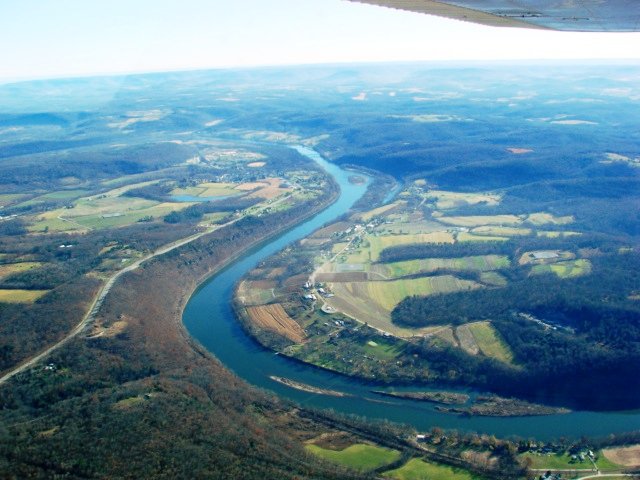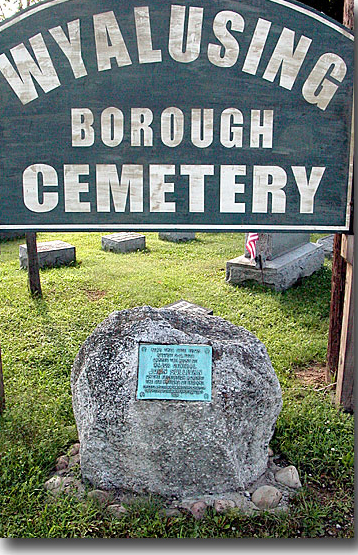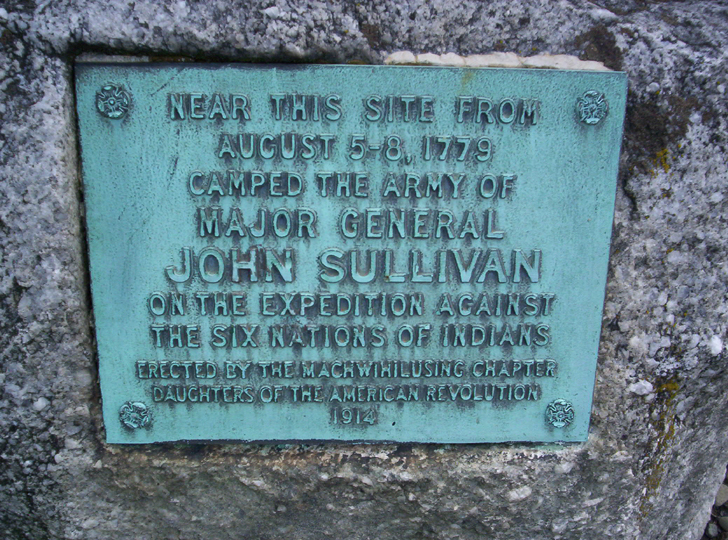Remembering Sullivan's March through
Region 225 Years Ago - by Pete Hardenstine - 7/29/2004
Wyalusing Rocket, Wyalusing, PA
In the spring of 1779, George Washington faced a dilemma.
While his Continental
Army kept watch over the main British force based in New York City, he was
forced to deal with the Indian and Tory threat to his rear.
On July 3, 1778,
an enemy force of approximately 1,000 Iroquois and Tories under the command of
Major John Butler culminated a summer of terror along the North Branch of the
Susquehanna River with an assault on the fertile Wyoming Valley.
The Wyoming
Valley Massacre claimed an estimated 160 to 320 lives
Washington’s solution
was to split his force, sending nearly a third of his tiny army on a punitive
raid into Iroquois country.
The expedition, under the command of Gen. John
Sullivan, left its mark on Wyoming and Bradford counties as well as the Finger
Lakes region where the force waged a scorched-earth attack against the Iroquois
homeland.
Sullivan’s March began in Wilkes-Barre on July 31, 1779—225 years
ago.

Susquehanna River
Wyalusing Rocks Lookout on Left
Along Route Taken by Sullivan's March
Source: Aerial Photograph Taken by Lyle Rockwell
November 12, 2010
Frontier under Siege
In the summer of 1778, the British
army, which had spent the previous winter encamped in Philadelphia, marched
across New Jersey to return to New York.
A hard-fought battle with
Washington’s army at Monmouth, NJ, during the march convinced the British
leadership that the Continental army was dramatically improved despite its hard
winter at Valley Forge.
With its main force bottled up in New York, the
British government sought to exploit a perceived Patriot weakness.
The
frontier to Washington’s rear was vulnerable to Indian raids, especially in the
northern Susquehanna River valley.
From its base in Fort Niagara, the British
encouraged the Iroquois Confederation to assault the vulnerable
settlements.
At the least, the Indian raids would slow the flow of foodstuffs
from the rich agricultural country to Washington’s army.
Urged to assault
people of “every age, sex and condition,” the Iroquois were willing allies of
the British.
As early as January 1778, the Indian threat became obvious in
what is now Bradford County.
Lemuel Fitch of Standing Stone was kidnapped
from his home that month and eventually died in captivity near Niagara.
At
Wyalusing, Amos York was taken captive in February, and Nathan Kingsley was
kidnapped in March.
In late March, Col. Dorrance and a force of 150 men
arrived from the Wyoming Valley to evacuate the settlers in the Wyalusing
area.
On May 20, a large Indian raid struck Wysox.
In June, a
force of 400 Indians and 400 Tories under Butler departed Tioga, the current
site of Athens, and headed downriver with its sights set on the Wyoming
Valley.
This group was reinforced by 200 Seneca warriors near the mouth of
Bowman’s Creek.
On June 30, the raiders fought a skirmish with a party
from Fort Jenkins.
On July 3, Butler demanded the surrender of all forts,
Continental soldiers and stores in the Valley.
A Patriot force instead
moved out to engage the enemy, but was routed.
Many of the captives were
brutally murdered in captivity by the Iroquois leader Queen Esther.
In the
aftermath, Butler’s Indians claimed taking 227 scalps, while Col. Nathan Denison
of the Connecticut militia reported 301 dead.
While Butler and his main force
returned victorious upriver on July 8, the last of the settlers in the Wyoming
Valley headed for safety by July 18.
In September, Col. Thomas Hartley
and 200 men led a raid from Fort Muncy up the Sheshequin Trail to take the fight
to the Indians.
After a skirmish near Canton, Hartley reached current day
Ulster where he destroyed Queen Esther’s village.
Retiring down the
Susquehanna, Hartley fought off an assault on Indian Hill on Sept. 29. He lost
four who were killed and had 10 soldiers injured in the
attack.
The Plan
With his rear, including his vital supply
sources, threatened, Washington decided to act against the Indian and Tory
threat.
Early in 1779, he developed a plan to take the fight to the Iroquois
and, if all went well, force the British at Niagara to use their vital supplies
to keep their Indian allies over the coming winter.
Giving the assignment to
Gen. Sullivan, a veteran commander from New Hampshire, Washington’s orders were
clear.
“The expedition you are appointed to command is directed against the
hostile tribes of the Six Nations of Indians, with their associates and
adherents. The immediate objects are the total destruction and devastation of
their settlements and the capture of as many prisoners of every age and sex as
possible. It will be essential to ruin their crops now in the ground and
preventing their planting more…”
Sullivan was to gather 11 regiments at
Easton, march across the Poconos to Wilkes-Barre and move up the Susquehanna to
Tioga.
Meanwhile, in upstate New York, Gen. James Clinton was to bring five
regiments downriver from Otsego Lake (modern day Cooperstown) and meet
Sullivan’s main force at Tioga.
Out west, a single regiment under Col.
Daniel Broadhead was to advance from Fort Pitt up the Allegheny River and, if
possible, to meet up with Sullivan’s force.
In all, nearly a third of
Washington’s army would be detached for the expedition.
Sullivan arrived
at Easton on May 7, but the logistics of gathering and supplying such a large
force on a wilderness march forced a lengthy delay.
It wasn’t until June 23,
when a road had been completed over the Poconos, that Sullivan’s force departed
Easton for Wilkes-Barre.
Sullivan’s March
On July 31,
Sullivan was finally ready.
A force of 2,300 men, eight artillery pieces,
1,200 pack horses, approximately 800 cattle and 120 boats pushed off from
Wilkes-Barre.
Col. Thomas Proctor commanded the flotilla of boats.
Three
brigades, commanded by generals Edward Hand, William Maxwell and Enoch Poor,
made up the force, along with Proctor’s artillery regiment that included two
six-pounder cannon, four three-pounders and a pair of howitzers.
The
Pennsylvanians, under Hand, was the vanguard for the advance along the east bank
of the Susquehanna, usually staying a mile ahead of the main body.
Maxwell’s
New Jersey brigade advanced along the right flank, while Poor’s brigade of New
Hampshiremen and Massachusettsmen held the left flank.
A small group of 60
men under Capt. William Gifford advanced up the west side of the river.
The
large force, encumbered by its huge supply train, moved slowly up the
river.
By Aug. 3, it reached the mouth of the Tunkhannock Creek. On Aug.
4, it arrived at the Vanderlip and Williamson farms near current day Black
Walnut.


